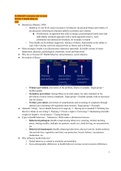SUMMARY Literature and Lectures
WEEK 1 Health Behavior
LEC
● Intermezzo (Blaxter, 1990)
○ Health as (1) not ill (2) reserve/resource (3) behavior (4) physical fitness and vitality (5)
psychosocial well-being (6) function (ability to perform one’s duties)
■ Psychosocial: an approach that seeks to merge a psychological (more mico-and
individually oriented) approach with a social approach (macro-, more
community-and interaction-oriented), for example, to health
○ Thus health can be defined: negatively: absence of illness, functionally as the ability to
cope with everyday activities and positively as fitness and well being
● Main messages: health is an idiosyncratic experience (personal) & health consists of many
dimensions: physical, psychological, emotional, social and behavioral
● Why do we become ill? Health behavior, stress/emotions, social relations
● Prevention of Illness
○ Primary prevention: prevention of the problem, illness or casualty. Target group =
healthy people
○ Secondary prevention: tracing illness in an early phase, for early treatment or for
prevention of more serious complaints. Target group = (healthy) people with an increased
risk for disease
○ Tertiary prevention: prevention of complications and worsening of symptoms through
optimal care (including self-regulation interventions). Target group = ill people
● Alameda 7 Study - Seven Health Factors for Longevity: 1. Having never smoked 2. Drinking less
than five drinks in one sitting 3. Sleeping 7-8 hours a night 4. Exercising 5. Maintaining desirable
weight for height 6. Avoid snacks 7. Eating breakfast
● Types of health behaviors - Matarazzo (1984) makes a distinction between:
○ Behavioral pathogens (health compromising behaviors): smoking, alcohol and drug
abuse, sharing needles, multiple sex partners, unsafe sex, drink driving, no ear protection,
etc.
○ Behavioral immunogens (health enhancing behaviors): physical activity, health nutrition
(fat and salt-less, vegetables and fruit), sun protection, bicycle helmet, vaccinations,
medication, etc.
● Why influence health behavior?
1. Health behavior is related to mortality and morbidity
2. Socio-demographic differences in health behavior increase social economic differences
1
, 3. The prevalence of risk behaviors is high e.g. smoking/ alcohol consumption
4. Health behavior is not always an informed choice (the environment/society tempts us to
choose unhealthy behaviors)
● Behavior change - adverse effects may occur: Increases of SES differences, hardening,
stigmatising
Chapter 1
What is health?
Historical overview
● Stone Age: trephination (hole in skull is made to release evil spirits)
● Middle ages. Illness was seen as God’s punishments
● Humoral theory (Hippocrates): illness due to imbalance of 4 humours, healing involves bleeding
or starvation
1. Excessive yellow bile: choleric/angry temperament
2. Excessive phlegm: calm/phlegmatic temperament
3. Excessive blood: optimistic/sanguine personality
4. Excessive black bile: sadness
● Galen: physical or pathological basis for all ill health (physical or mental). Dominant
temperaments (sanguine, choleric, phlegmatic, melancholic) contribute to illnesses.
○ Mind and body were interrelated but only in terms of physical and mental disturbances
having an underlying physical cause. Mind did not play a role in illness aetiology.
E.g. melancolic women were more likely to get breast cancer due to high levels of black bile.
● Early 17th century: Dualism (descartes): mind (nonmaterial) vs body (material)
● Mechanistic viewpoint (Dualists): reductionist approach that reduces behavior to the level of the
organ or physical function. Body understandable in terms of its constituent parts (molecular
biological biochemical, genetic → organic medicine) → illness understood through cellular and
physiological processes
Biomedical model of illness: reductionist approach → behavior can be reduced to cells, neural activity,
biochemical activity. Diseases have an underlying physiological explanation. Health = absence of disease.
Symptoms of illness have an underlying pathology that hopefully can be cured through medical
intervention.
● Ill through exposure to contagious ‘agents’, insufficient immune system
● Ignores evidence that different people respond in different ways to the same underlying disease
pathology due to variations in personality, cognition, social support resources, cultural beliefs etc.
Today, Biopsychosocial model (more holistic)
● Body and mind in interaction determine health and
illness
● Consequences of interplay of biological (genes,
pathogens), psychological (emotions, cognition
and behavior) and social (norms, social cultural
background) factors
● The different systems influence each other
continuously
2
,Challenging dualism: psychosocial models of health and illness
● Illnesses can be perceived in objectively or subjectively
○ Subjectivity: beliefs, expectations and emotions interact with bodily interaction to play
an important role in the illness of stress experience
○ Role of the ‘mind’ in the manifestation of and response to illness e.g. phantom limb pain
or placebo effect
● Freud: examination of patients with physical symptomatology but no identifiable cause, using
hypnosis and free association techniques, he identified unconscious conflicts which had been
repressed
= Stimulated work into unconscious conflict, personality and illness → development of the field
of psychosomatic medicine
Models of disability: from biomedical to biopsychosocial (= diseases and symptoms can be explained by
a combination of physical, social, cultural and psychological factors)
● In the WHO ICI-D-H model, impairments (abnormalities/losses of organs, tissues, structures or
appearance) lead to disability (restriction/inability to function as ‘normal for a human being’)
which creates individual handicap (experienced disadvantages in fulfilling normal social roles)
○ What about individuals who have ‘impairment’ but functions typically if e.g. adhere to
medication?
○ Perceived stigma leads to disadvantages
● Evidence of individual variation in the response to impairment and disability challenges
biomedical thinking and opens door for biopsychosocial thinking
● ICF (International Classification of Functioning, Disability and Health) presents a universal,
dynamic, non-linear model: alterations in bodily structure/function (replaces impairment);
activities and limitations therein (replaces disability), participation and restrictions herein
(replaces handicap) can all affect each other
○ Relationship between structures, activities and participation are influenced by both
environmental and personal factors
= Disability no longer resides within the individual, but is a response to other factors including physical,
social and cultural environment and personal characteristics, behavioral and illness related beliefs and
feelings
= Views of health have shifted from fairly holistic views, where mind and body interact, to more dualist
views, where the mind and body are thought to act independently of one another. This is shifting back
towards holism, with the medical model being challenged by a more biopsychosocial approach.
3
, Behavior, death and disease
● Dramatic increase in life expectancy in Western countries in the 20th century, partly due to
advances in medical technology and treatments → general belief in western cultures in the
efficacy of traditional medicine
○ Antibiotics (1940s), increased control of infectious diseases though vaccinations and
improved sanitation, are partial explanations of increases in life expectancy globally
● Cultural variations explained by differences in lifestyle and diet & Gender variations explained by
differences in health behaviors
● Current concern: rising obesity in children and consequences health effects in adulthood → lower
life expectancy in the future (especially in UK and USA)
● Fall in mortality due to immunisation programmes and public health successes following social
and environmental changes over time (developments in education, agriculture, changes in diet,
improvements in public hygiene and living standards)
● Biggest killers worldwide: diseases such as heart, lung, respiratory diseases (along with
accidents)
● Top 10 causes of deaths: Ischaemic heart diseases, stroke, lower respiratory infection, COPD,
diarrheal disease, HIV/AIDS, lung disease (including cancer), diabetes mellitus, road injury,
prematurity
● ! Leading causes of death have a behavioral component e.g. smoking,excessive alcohol
consumption, poor diet/obesity
= Individual behavior, health and illness are a key reason as to why health psychology has grown rapidly
● People live longer → reaching ages where cancer incidence (the number of new cases of disease
occurring during a defined time interval) is greater
Individual, cultural and lifespan perspectives on health
Lay theories of health
● Bauman found 3 main types of response whereby being healthy was considered → health is
related to ...
1. General sense of wellbeing → feeling
2. Identified with the absence of symptoms of disease → symptom orientation
3. Seen in the things that a person who is physically fit is able to do → performance
● Bennet distinguished between health as
1. Being (if not ill then healthy)
2. Having (health as a positive resource/reserve)
3. Doing (physical fitness/function)
● Subjective well-being ratings have been found to correlate strongly with objective health
indicators. Subjective evaluations are typically reached through comparison with oaths, thus
health concept can be shaped → a young person will tend to perceive their peers as generally
healthy vs older people when in poorer health are more likely to compare themselves with
same-aged peers who may generally have normatively poorer health
WHO definition of Health (1948): Health is a state of complete physical, mental and social well-being
and not merely the absence of disease or infirmity
4






